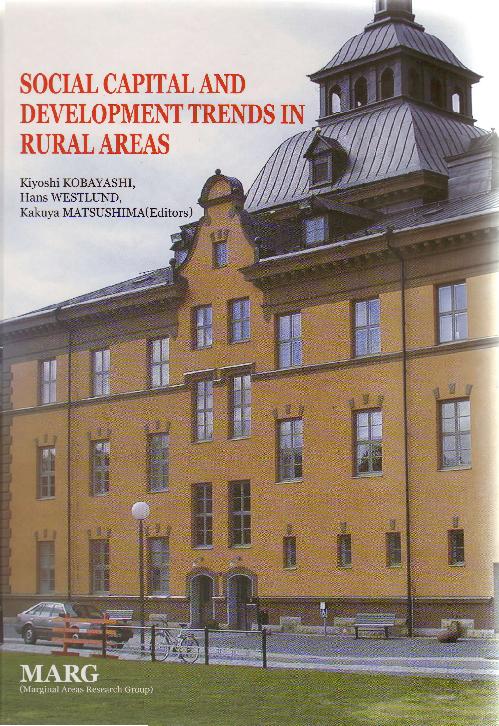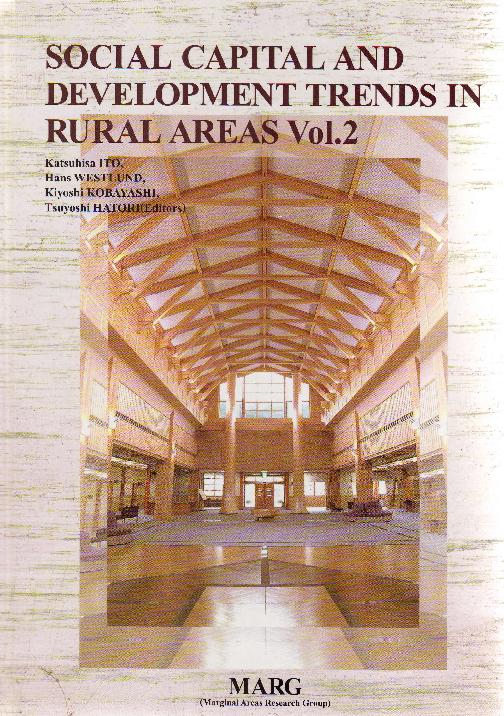What’s new!
| No. | 所属 | 氏名 |
| 1 | 京都大学大学院工学研究科都市社会工学専攻 | 小林 潔司 |
| 2 | Prof. National Institute of Working Life (ALI), Sweden | Hans WESTLUND |
| 3 |
Director, Centre for Regional Science CERUM, Umeå University, Sweden | Lars Westin |
| 4 |
Prof. & Chairman of CERUM, Umeå University, Sweden |
Ulf Wiberg |
| 5 |
日南町総合政策課 課長 | 内田 格 |
| 6 |
専修大学教授 |
松尾 容孝 |
| 7 |
島根大学生物資源科学部 | 伊藤 勝久 |
| 8 |
鳥取大学准教授 | 谷本 圭志 |
| 9 |
大阪大学大学院文学研究科 | 堤 研二 |
| 10 |
(株)ニュージェック | 安野 貴人 |
| 11 |
野村総合研究所 | 植村 哲士 |
| 12 |
(株)計画情報研究所 | 北原 良彦 |
| 13 | 八千代エンジニヤリング(株) | 神永 希 |
| 14 | 京都大学大学院工学研究科都市社会工学専攻 | 松島 格也 |
| 15 | 京都大学大学院工学研究科都市社会工学専攻 | 鄭 蝦榮 |
| 16 | 京都大学大学院工学研究科都市社会工学専攻 | 西畠 綾 |
| 17 | 京都大学大学院経営管理専門職大学院 | 北原 彩佳 |
| 2006.07.22 | 第一回 | : 話題提供(鄭蝦榮・植村・安野・松尾) |
| : MARGの運営について | ||
| 2006.10.14 | 第二回 | : 中山間地域のEmployabilityについて(安野) |
| : 森林施業計画あたりと森林会計上の負債について(植村) | ||
| : 人文地理学における行動研究大阪大学人文地理学教室での研究事例を中心に(堤) | ||
| 2007.01.08 | 第三回 | : コミュニティカードをカード事業、会員事業を地域活性化につなげる方策(西田純二、社会システム総合研究所) |
| : ソーシャル・ベンチャー、起業的活動について(安野) | ||
| : 観光地太宰府の形成(堤) | ||
| 2007.04.16 | 第四回 | : 国産木材流通の変化と森林管理(能口秀一, (有)ウッズ) |
|
: 日南町公共交通の社会実験に向けた取り組み(谷本) |
||
|
: The 4th Workshop on Social Capital and Development Trends in Japan’s and Sweden’s Countryside in conjunct with World Conference of IGU/C 04.27、Kitami (北見ワークショップ)について(松尾) |
||
| : 起業的移行を促す地方施策とソーシャルリスク分析(安野) |
◆ Social Capital and Development Trends in Rural Areas、 Kiyoshi KOBAYASHI, Hans WESTLUND, Kakuya MATUSHIMA(Editors), 2005, ISBN: 4-907830-04-1

|
Contents |
|
|
Chapter1 |
Socail Capital and Rural Developmet |
|
Chapter2 |
Forest Governance Towards Sustainable Management of Common-Pool Resources: Private Descriptions of the Problem and Consensus Formation |
|
Chapter3 |
Global Fear Interesting with Local Development-A Case Study of the Glocal Perspective in a Rural Setting- |
|
Chapter4 |
Learning in Practice-When Social Economy Meets Resional Development |
|
Chapter5 |
Rural Areas, Demographic Change |
|
Chapter6 |
Examining Japanese Rural Policies From the Viewpoint of Social Captica:Towards the Integrated Initiatives of Food Production, Land Management and Vibrant Comminities |
|
Chapter7 |
Local Responses to Structural Changes-Local Development Groups in Rural Communities in Swenden |
|
Chapter8 |
Fundamental Funtions of Living , Social Capital and Agents in a Small Community – A Case in Depopulated Areas in Japan |
|
Chapter9 |
Who are the Successors of Rural Communiites in Japan? |
|
Chapter10 |
Future Perspectives for Sparsely Populated Areas in Sweden |
|
Chapter11 |
Activity Analysis on Diray Data |
|
Chapter12 |
Concentration of Transportation Demand in Marginal Area |
|
Chapter13 |
Challenges to Insular Income Systems in the Nordic Countires |
|
Chapter14 |
Does Social Capital Contribute to Regional Economic Growth?Swedish Experiences |
◆ Social Capital and Development Trends in Rural Areas Vol2、 Katsuhisa ITO, Hans WESTLUND, Kiyoshi KOBAYASHI, Tsuyoshi HATORI(Editors), 2006, ISBN: 4-907830-05-X

|
Contents |
|
|
Chapter1 |
Socail Capital and Rural Developmet |
|
Chapter2 |
GONGOVA and the Shin-etsu Trail: Fact-reports on Volunteer Activities and Trekking Trails for Revitalizatio of Underprivilieged Regions |
|
Chapter3 |
Forest Governance: Structure and Function |
|
Chapter4 |
Trust Formation for Collaborative Forest Management |
|
Chapter5 |
Toward Developing Forest-Accounting for the Local Government who Supports the Forest Management |
|
Chapter6 |
Trading Natural Resources for Public Grants. Development Rhetorc, Image, and Social Capital in North Swenden |
|
Chapter7 |
Restructuring in Sparse Regional Structures-a Swedish Case |
|
Chapter8 |
Settlement Patterns on the Swedish Countryside in the Emerging Knowledge Society |
|
Chapter9 |
Social Ties in Communities-Some Rural and Urban Cases in Japan |
|
Chapter10 |
Swedish Regions Ready for Growth?-Findings From a Pilot Project on Regional Development |
|
Chapter11 |
Rural Development Through GES Tourism: Are the Networks and Institutions Evolving as the Alternative Social Capital? |
|
Chapter12 |
The Condition of Community Promotion Through Reforming Old Community in Rural and Mountainous Villages |
|
Chapter13 |
Quantile Analysis of Joint Activity on Diary Data |
|
Chapter14 |
Merits and Demerits of Cash Flow Smoothing Asset Management |
|
Chapter15 |
Quality of Life, Social Capital and Community Asset Management |
本の購入に関するお問い合わせは、こちらからお願いいたします。